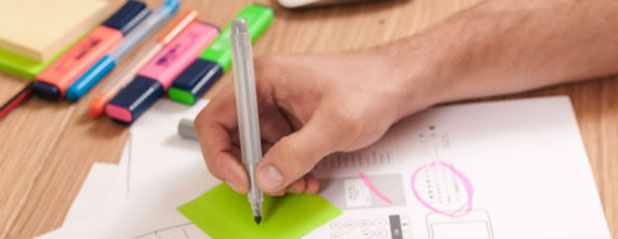The top 15 skills needed to be a User Experience (UX) Designer in 2022

A User Experience (UX) Designer is responsible for creating the interface of a company’s digital platform, this could be a website, mobile application, or an operating system. They are responsible for ensuring the platform is easy to use and accessible.
With the world becoming digital, UX Designers are essential to companies who want to gain more loyal customers. Having a positive UX will increase audience engagement which leads to conversions and increased revenue. We have put together a list of the top 15 skills needed to be a UX Designer in 2022.
1. User Experience
In order to understand user experience, you need to know about various personas and how best to market your product to a specific target group. When considering UX within your design you need to think about the following factors:
- Is it useful
- Is it usable
- Is it desirable
- Is it accessible
- Is it credible
- Is it findable
- Is it valuable
2. Mock-ups Wireframes & Prototyping
Being able to prototype your designs brings your product concepts to life, allowing you to see if your creative ideas are achievable or not. Wireframing involves displaying content and functions on a basic level whereas a prototype is in greater detail and closer to the final product. You might present prototypes to your target audiences to get feedback so you can make changes before producing the final product.
3. Knowledge of Visual Design Software
UX Designers will need to understand how to use several different design software including Figma, Sketch, Adobe, and InVision. The software is dependent on company preference, but the more you know the more impressive you will appear to employers. The more you can practice in your spare time the better you will become at using these applications. It’s important to be aware of any app features that can help you produce innovative creative ideas as well.
4. User Research & UX research
As a UX Designer, you need to understand who your target audience is, and therefore you need to be proactive in researching how best to market your product to them. It is important to find out their needs, goals, and buying habits. The more research you do the better informed you become to be able to put together a valuable product.
5. Workshop facilitation
Part of your user research may involve hosting workshops with your target audience. Facilitating workshops allows you to bring a range of perspectives that can help uncover problems and solutions quicker. They ensure a team-based approach, allowing everyone to be on the same lines of communication often enabling faster results.
6. Usability Testing
Usability testing ensures there are no problems before the website or application is live. These tests take place throughout the design process as spotting mistakes earlier will save you time and money overall. During usability testing, you will be able to analyse user satisfaction, from how long it takes to complete a task, if they can complete specific tasks and if they come across any errors.
7. Interaction Design, User-Centred design
Interaction Design is a vital skill for any UX Designer, this involves any interaction that the user has with your website or app. This can be from something as simple as a click, swipe, or typing. There are five dimensions of interaction design including, words, visual representation, physical objects or space, time, and behaviours. All of these aspects need to be considered in order to create an engaging platform.
8. Customer Experience (CX)
UX operates in line with CX and therefore it’s good to understand how both work. The simple difference is that not all users are customers, and so CX considers interactions across multiple applications, with the brand as a whole rather than just the webpage. In smaller companies, the two roles would most likely overlap.
9. HTML/ CSS
Whilst learning to code isn’t essential for a UX Designer, it certainly won’t harm to learn the basics. Learning the basics will mean you have better communication with the development team, it will also help you understand and appreciate the developer’s work and processes.
10. Mobile App Development
As well as to be able to design websites, UX Designers should learn about mobile app development. With so many people nowadays using their phones and apps for services, an employer will value someone who knows how to create mobile apps as well as how to make a web page appear mobile-friendly. Mobile optimisation is also a key feature of maintaining good SEO.
Soft Skills of a UX Designer
As a UX Designer, you can have all the experience and technical skills in the world, however, the difference in getting a job could be your soft skills. Soft skills are often discussed at interview stages, as employers will ask for examples of certain situations on how you have handled tasks or interacted with colleagues. It is important to understand the most desired soft skills need to be a great UX Designer.
11. Communication
Communication is essential for UX Designers, as you need to be able to articulate your designs and decisions to senior colleagues. This also means being able to communicate the technical aspects of your work to an audience that might not understand the terminology. From time to time when you begin a project you may also be required to put together presentations therefore both verbal and nonverbal communication skills are important.
12. Critical Thinking
Critical thinking skills will help you boost your creativity as it allows you to ask a variety of questions in multiple situations, which will help you think of innovative solutions to user issues. It is also important for UX Designers to be able to understand buying habits as well as develop foresight of user needs.
13. Flexibility
UX Designers need to be flexible in their everyday work. Often you produce different mock-ups and alternate versions from which you will receive feedback on preferences. You also need to be flexible in your designs, as not all users will follow the same path.
14. Creativity
Creativity is essential for UX Designers, as you need to be able to innovate new ideas that will appeal to a target audience. Creativity is a soft skill that can improve with practice and experimentation. To be able to think creatively can often help you produce new processes that can solve user issues in UX design.
15. Empathy
As a UX Designer, you are responsible for what users see when they first experience a new company online. Therefore, you need to be able to put yourself in the user’s position, being able to understand their frustrations, hopes, reasoning, and goals amongst many other emotions. Being empathetic can help you think of the solutions that will help users become loyal customers.
The demand for UX Designers has increased by 300% in the past 2 years and is one of the top skills to learn in 2022. So, if you are a creative person who enjoys analysing situations and thinking of innovative ways to solve issues then UX design could be for you.



